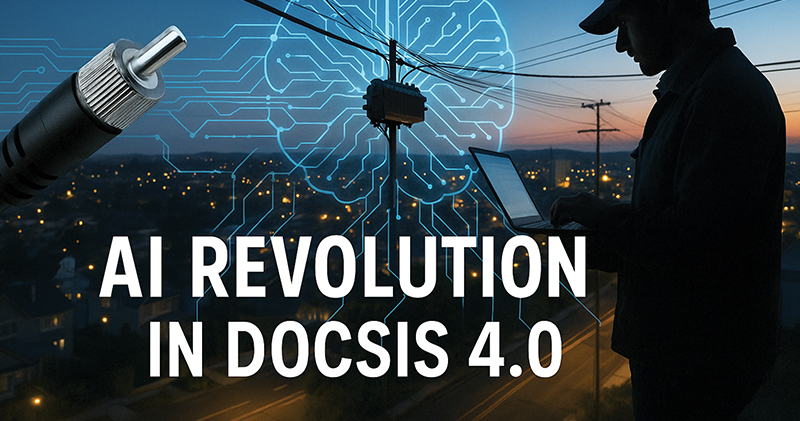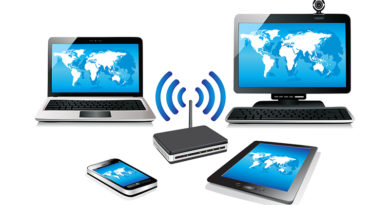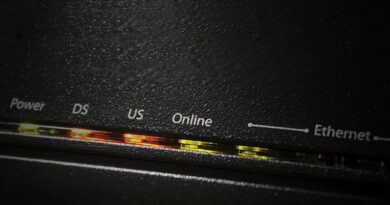AI: Cable’s Secret Weapon for 10G Reliability
By Brady Volpe
Artificial intelligence (AI) is no longer a lab curiosity for cable operators—it’s quietly rewriting the rules of DOCSIS operations. Following is an overview of my take on where artificial intelligence is delivering value today and how it will reshape high-speed data service as DOCSIS 3.1 and 4.0 roll-outs continue across North America and beyond, based on extensive research of the current state of technology. AI tech evolves fast—so buckle up!
Why AI and DOCSIS are a natural pair
DOCSIS networks already generate terabytes of telemetry (SNR, RxMER per subcarrier, pre-EQ taps, PMA profile data, Wi-Fi analytics, and more). Machine learning (ML) models thrive on this scale, extracting patterns humans miss and acting in milliseconds. Three forces are converging, and together they shrink mean time to repair (MTTR) from hours to minutes:
- Full duplex (FDX) and extended spectrum DOCSIS (ESD) 4.0 push multi-gig symmetric speeds but raise complexity.
- Edge silicon with embedded AI engines (e.g., Comcast–Broadcom unified DOCSIS 4.0 chipsets) bring inference closer to the impairment.[1]
- Cloudscale analytics and LLM assistants slash the time from insight to action, giving operators a near realtime “nervous system.”[2]
What AI delivers today
AI has graduated from proof-of-concept to everyday workhorse in DOCSIS operations. From the network operations center (NOC) to the node, ML engines now parse terabytes of telemetry, forecast failures, and take split-second remedial actions. The bullets below highlight the most mature use cases already delivering measurable ROI.
- PNM detects upstream noise bursts, water ingress, reflections, or laser clipping days before failure, avoiding truck rolls.
- Fault localization leverages modem correlations to pinpoint issues to a 50-foot drop span instead of a 500-foot feeder.
- Traffic optimization via the profile management application (PMA) dynamically allocates OFDMA and OFDM blocks or FDX echo cancellation resources, cutting peak hour latency and reducing node splits.
- Self-healing actions (auto-reprofiling and channel swaps) now trigger without human intervention.
- Customer support AI in gateways trims truck rolls by 62 % and drops churn.[3] See Figure 1 for relative impact.
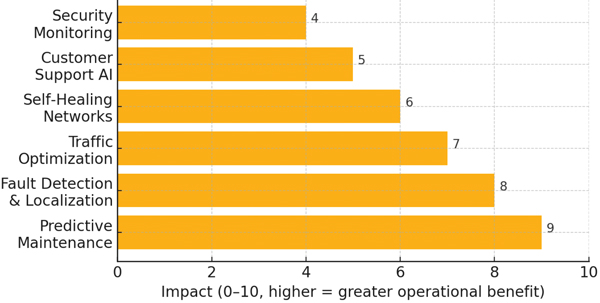
Figure 1. Relative impact of AI use cases in DOCSIS networks compares operational value across six key domains.
How AI Is changing traffic patterns
Once the network can heal itself, the very character of traffic begins to shift. AI’s real-time optimization removes bottlenecks, paving the way for new usage behaviours—think symmetrical creator workloads, persistent cloud gaming, XR (extended reality) classrooms and real-time digital twins. Three trends stand out:
- Symmetry is rising: With confident upstream quality, cloud backup, livestreaming and XR create steadier bidirectional loads.
- Latent capacity unlocked: AI tunes modulation profiles per modem every hour, squeezing extra bits from clean drops while protecting marginal ones.
- In-home optimization: Edge AI repositions Wi-Fi channels or suggests mesh extenders, smoothing demand bursts seen by CMTS cores.
While this may sound like magic, it is occurring today through PMA, PNM and other ML and AI initiatives across many cable operators. As an industry we have achieved gigabit or multi-gigabit speeds—that is remarkable—now we are using ML and AI tools to achieve reliable multi-gigabit speeds.
Looking to 2030 and beyond
North America leads DOCSIS 4.0 + AI deployment integrations, but European cable operators and selected South American groups (e.g., Liberty Latin America) quickly follow.[4] By 2030 analysts anticipate the following:
- Based on Charter and Comcast public roadmaps, >70% of NA homes will sit behind AI-enabled DOCSIS 4.0 nodes.[5] (See Figure 2 for projected rollout)
- Self-healing becomes table-stakes—operators automate >99% of config changes, slashing human error outages.[6]
- Generative AI copilots answer RF engineers’ queries (“Where should I split this node?” or even “Should I split this node?”) and auto draft field repair steps.
- Green gains: AI throttles amps overnight, trimming HFC power budgets 10% to 20%—while an ANSI/CEA 2049-2015 test procedure from 2015, AI in smart amps can now make it possible.[7]
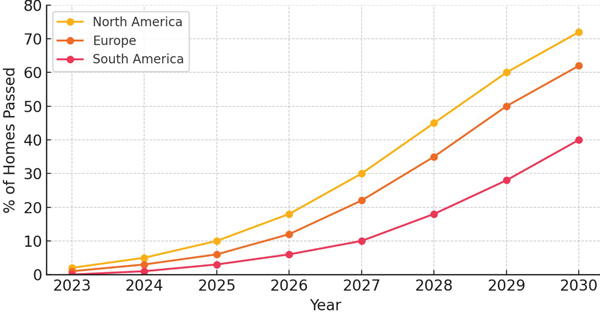
Figure 2. Projected rollout of AI enabled DOCSIS 4.0 networks charts adoption through 2030 in NA, EU and SA regions.
Business implications—why this matters beyond the NOC
AI’s value in DOCSIS is measurable both in dollars saved today and in market position secured for tomorrow. The table in this section distills four high impact levers, mapping each to two outcomes:
- Direct Payoff captures the hard financial win operators can book in the current fiscal cycle—lower truck roll OPEX, fewer SLA penalties, or deferred capital spend.
- Strategic Gain highlights the soft but equally critical upside—higher net promoter scores, faster feature velocity, and a brand narrative of “AI powered reliability” that helps cable fend off fiber challengers.
For example, PNM uses ML models to flag degrading coax or optics days before failure. That preemptive work cuts unplanned repair OPEX by 30% to 50% and boosts customer satisfaction, reducing churn.[8] AI chat/edge diagnostics shift Tier 1 support to gateways and chatbots, eliminating 62% of truck rolls and giving cable operators a friction free customer experience that rivals (or beats) all fiber ISPs.[9] Self healing automation drives 99% config accuracy, shrinking outage minutes and accelerating DOCSIS 4.0 feature rollouts, while AI driven capacity planning turns “best guess” node splits into just in time upgrades, freeing capital for strategic initiatives like Wi-Fi 7 or edge cloud.[10]
In short, each lever delivers an immediate P&L benefit and sets the stage for sustainable competitive advantage—transforming AI from a science project line item into the economic engine of the 10G era.

Table 1. Value add from different levers derived in AI transformations.
Takeaway
AI won’t swing a hammer or pull new coax, but it will rewire the network’s brain for the 10G era. By stitching intelligence from the cloud all the way to the tap, it turns a 60 year old plant into a self-aware, self-optimizing platform. That shift reshapes roles—automating routine tasks that occupy today’s CSRs and even some management layers—yet opens new opportunities in data driven engineering and customer innovation. In short, the impact touches everyone from the CEO to the subscriber.
- Operators and ISPs—Proactive analytics trim minutes of downtime and free up capital for growth. Begin by feeding modem telemetry into a lightweight ML pipeline and benchmarking savings.
- Engineers and Field Techs—Pair RF intuition with data-science chops. SCTE’s AI and Analytics courses and CableLabs’ working groups on pre-EQ data offer a head start.
- Vendors and Integrators—Design nodes, amps and gateways with onboard compute and open telemetry APIs; customers will demand ‘AI-ready’ gear within two budget cycles.
- Students and Career-Changers—Join SCTE or CableLabs working groups, contribute to open-source telemetry projects, and build credibility in an industry hungry for AI talent.
The bottom line: AI is here. Just like broadband itself, smartphones, and on-demand streaming, AI is poised to continue to change our industry and our daily lives. So, lean into it, not away from it. Learn fast and help steer this roadmap rather than react to it. Organizations that embrace data-driven automation will set the pace for the next decade of broadband.
References:
- https://corporate.comcast.com/press/releases/comcast-broadcom-develop-ai-powered-access-network-pioneering-new-chipset
- https://www.cablelabs.com/blog/empowering-field-operations-with-agentic-ai
- https://www.hitrontech.com/press-releases/hitron-partners-with-aprecomm-to-deliver-pre-integrated-ai-powered-solutions-for-broadband-service-providers
- https://www.lightreading.com/cable-technology/docsis-4-0-gaining-traction-with-cable-ops-survey
- https://www.lightreading.com/cable-technology/charter-plots-big-multi-gig-network-wireless-upgrades
- https://www.lightreading.com/cable-technology/comcast-our-automated-network-can-prevent-at-t-style-outages
- https://www.cablelabs.com/blog/a-new-voluntary-agreement-for-energy-efficiency-home-internet-equipment
- https://www.lightreading.com/ai-machine-learning/nokia-maps-out-ai-ml-automation-path-for-broadband-operators
- https://www.hitrontech.com/press-releases/hitron-partners-with-aprecomm-to-deliver-pre-integrated-ai-powered-solutions-for-broadband-service-providers
- https://www.lightreading.com/cable-technology/comcast-our-automated-network-can-prevent-at-t-style-outages.

Brady Volpe
Mr. Volpe, the Chief Product Officer at OpenVault, brings over 30 years of experience in the broadband cable and telecommunications industry. As the founder of The Volpe Firm, Inc., and Nimble This (now OpenVault), he has been instrumental in product development and successful launches. Through his acclaimed blog, podcast, and livestream, he shares expertise in high-speed data, DOCSIS, PNM, HFC, ML, PMA, and more. Mr. Volpe has an unwavering commitment to broadband innovation.
—
Figures provided by author

